Investigation on the Thermal Characteristics of Enhancement-Mode p-GaN HEMT Device on Si Substrate Using Thermoreflectance Microscopy
Abstract
:1. Introduction
2. Device Structure and Mechanism
3. Results and Discussion
4. Conclusions
Author Contributions
Funding
Conflicts of Interest
References
- Lee, K.-T.; Bayram, C.; Piedra, D.; Sprogis, E.; Deligianni, H.; Krishnan, B.; Papasouliotis, G.; Paranjpe, A.; Aklimi, E.; Shepard, K.; et al. GaN Devices on a 200 mm Si Platform Targeting Heterogeneous Integration. IEEE Electron. Device Lett. 2017, 38, 1094–1096. [Google Scholar] [CrossRef]
- Greco, G.; Iucolano, F.; Roccaforte, F. Review of technology for normally-off HEMTs with p-GaN gate. Mater. Sci. Semicond. Process. 2018, 78, 96–106. [Google Scholar] [CrossRef]
- Xin, Y.; Chen, W.; Sun, R.; Shi, Y.; Liu, C.; Xia, Y.; Wang, F.; Li, M.; Li, J.; Zhou, Q.; et al. Analytical Switching Loss Model for GaN-Based Control Switch and Synchronous Rectifier in Low-Voltage Buck Converters. IEEE J. Emerg. Sel. Top. Power Electron. 2019, 7, 1485–1495. [Google Scholar] [CrossRef]
- Hsu, L.-H.; Lai, Y.-Y.; Tu, P.-T.; Langpoklakpam, C.; Chang, Y.-T.; Huang, Y.-W.; Lee, W.-C.; Tzou, A.-J.; Cheng, Y.-J.; Lin, C.-H.; et al. Development of GaN HEMTs Fabricated on Silicon, Silicon-on-Insulator, and Engineered Substrates and the Heterogeneous Integration. Micromachines 2021, 12, 1159. [Google Scholar] [CrossRef]
- Fei, C.; Ahmed, M.H.; Lee, F.C.; Li, Q. Two-Stage 48 V-12 V/6 V-1.8 V Voltage Regulator Module With Dynamic Bus Voltage Control for Light-Load Efficiency Improvement. IEEE Trans. Power Electron. 2017, 32, 5628–5636. [Google Scholar] [CrossRef]
- Mu, M.; Lee, F.C. Design and Optimization of a 380–12V High-Frequency, High-Current LLC Converter with GaN Devices and Planar Matrix Transformers. IEEE J. Emerg. Sel. Top. Power Electron. 2016, 4, 854–862. [Google Scholar] [CrossRef]
- Goyal, V.; Subrina, S.; Nika, D.L.; Balandin, A. Reduced thermal resistance of the silicon-synthetic diamond composite substrates at elevated temperatures. Appl. Phys. Lett. 2010, 97, 031904. [Google Scholar] [CrossRef] [Green Version]
- Turin, V.O.; Balandin, A.A. Electrothermal simulation of the self-heating effects in GaN-based field-effect transistors. J. Appl. Phys. 2006, 100, 054501. [Google Scholar] [CrossRef] [Green Version]
- Wang, X.-D.; Hu, W.-D.; Chen, X.-S.; Lu, W. The Study of Self-Heating and Hot-Electron Effects for AlGaN/GaN Double-Channel HEMTs. IEEE Trans. Electron. Devices 2012, 59, 1393–1401. [Google Scholar] [CrossRef]
- Shamsir, S.; Garcia, F.; Islam, S.K. Modeling of Enhancement-Mode GaN-GIT for High-Power and High-Temperature Application. IEEE Trans. Electron. Devices 2020, 67, 588–594. [Google Scholar] [CrossRef]
- Wang, K.; Simon, J.; Goel, N.; Jena, D. Optical study of hot electron transport in GaN: Signatures of the hot-phonon effect. Appl. Phys. Lett. 2006, 88, 022103. [Google Scholar] [CrossRef]
- Mion, C.; Muth, J.F.; Preble, E.; Hanser, D. Accurate dependence of gallium nitride thermal conductivity on dislocation density. Appl. Phys. Lett. 2006, 89, 092123. [Google Scholar] [CrossRef]
- Zheng, Q.; Li, C.; Rai, A.; Leach, J.H.; Broido, D.A.; Cahill, D.G. Thermal conductivity of GaN, GaN71, and SiC from 150 K to 850 K. Phys. Rev. Mater. 2019, 3, 014601. [Google Scholar] [CrossRef]
- Tadjer, M.J.; Anderson, T.J.; Ancona, M.G.; Raad, P.; Komarov, P.; Bai, T.; Gallagher, J.C.; Koehler, A.D.; Goorsky, M.S.; Francis, D.A.; et al. GaN-On-Diamond HEMT Technology With TAVG = 176 °C at PDC,max = 56 W/mm Measured by Transient Thermoreflectance Imaging. IEEE Electron. Device Lett. 2019, 40, 881–884. [Google Scholar] [CrossRef]
- Choi, S.; Heller, E.R.; Dorsey, D.; Vetury, R.; Graham, S. The Impact of Bias Conditions on Self-Heating in AlGaN/GaN HEMTs. IEEE Trans. Electron. Devices 2013, 60, 159–162. [Google Scholar] [CrossRef]
- Heller, E.; Choi, S.; Dorsey, D.; Vetury, R.; Graham, S. Electrical and structural dependence of operating temperature of AlGaN/GaN HEMTs. Microelectron. Reliab. 2013, 53, 872–877. [Google Scholar] [CrossRef]
- Choi, S.; Heller, E.R.; Dorsey, D.; Vetury, R.; Graham, S. Thermometry of AlGaN/GaN HEMTs Using Multispectral Raman Features. IEEE Trans. Electron. Devices 2013, 60, 1898–1904. [Google Scholar] [CrossRef]
- Kendig, D.; Yazawa, K.; Marconnet, A.; Asheghi, M.; Shakouri, A. Side-by-side comparison between infrared and thermoreflectance imaging using a thermal test chip with embedded diode temperature sensors. In Proceedings of the 2012 28th Annual IEEE Semiconductor Thermal Measurement and Management Symposium (SEMI-THERM), San Jose, CA, USA, 18–22 March 2012; pp. 344–347. [Google Scholar]
- Kuball, M.; Hayes, J.M.; Uren, M.J.; Martin, I.; Birbeck, J.C.H.; Balmer, R.S.; Hughes, B.T. Measurement of temperature in active high-power AlGaN/GaN HFETs using Raman spectroscopy. IEEE Electron. Device Lett. 2002, 23, 7–9. [Google Scholar] [CrossRef]
- Bhojani, R.; Kowalsky, J.; Lutz, J.; Kendig, D.; Baburske, R.; Schulze, H.J.; Niedernostheide, F.J. Observation of current filaments in IGBTs with thermoreflectance microscopy. In Proceedings of the 2018 IEEE 30th International Symposium on Power Semiconductor Devices and ICs (ISPSD), Chicago, IL, USA, 13–17 May 2018; pp. 164–167. [Google Scholar]
- Yuan, C.; Pomeroy, J.W.; Kuball, M. Above bandgap thermoreflectance for non-invasive thermal characterization of GaN-based wafers. Appl. Phys. Lett. 2018, 113, 102101. [Google Scholar] [CrossRef] [Green Version]
- Farzaneh, M.; Maize, K.; Lüerßen, D.; Summers, J.A.; Mayer, P.M.; Raad, P.; Pipe, K.P.; Shakouri, A.; Ram, R.J.; Hudgings, A.J. CCD-based thermoreflectance microscopy: Principles and applications. J. Phys. D Appl. Phys. 2009, 42, 143001. [Google Scholar] [CrossRef]
- Chatterjee, B.; Dundar, C.; Beechem, T.E.; Heller, E.; Kendig, D.; Kim, H.; Donmezer, N.; Choi, S. Nanoscale electro-thermal interactions in AlGaN/GaN high electron mobility transistors. J. Appl. Phys. 2020, 127, 044502. [Google Scholar] [CrossRef]
- Chatterjee, B.; Lundh, J.S.; Dallas, J.; Kim, H.; Choi, S. Electro-thermal reliability study of GaN high electron mobility transistors. In Proceedings of the 2017 16th IEEE Intersociety Conference on Thermal and Thermomechanical Phenomena in Electronic Systems (ITherm), Orlando, FL, USA, 30 May–2 June 2017; pp. 1247–1252. [Google Scholar]
- Berman, R. Thermal Conduction in Solids; Clarendon Press: Oxford, UK, 1979. [Google Scholar]
- Jeżowski, A.; Danilchenko, B.; Boćkowski, M.; Grzegory, I.; Krukowski, S.; Suski, T.; Paszkiewicz, T. Thermal conductivity of GaN crystals in 4.2–300 K range. Solid State Commun. 2003, 128, 69–73. [Google Scholar] [CrossRef]
- AlShaikhi, A.; Barman, S.; Srivastava, G.P. Theory of the lattice thermal conductivity in bulk and films of GaN. Phys. Rev. B 2010, 81, 195320. [Google Scholar] [CrossRef]
- Kamatagi, M.; Sankeshwar, N.; Mulimani, B. Thermal conductivity of GaN. Diam. Relat. Mater. 2007, 16, 98–106. [Google Scholar] [CrossRef]
- Cheng, K.; Leys, M.; DeGroote, S.; Germain, M.; Borghs, G. High quality GaN grown on silicon(111) using a SixNy interlayer by metal-organic vapor phase epitaxy. Appl. Phys. Lett. 2008, 92, 192111. [Google Scholar] [CrossRef]
- Elsner, J.; Jones, R.; Sitch, P.K.; Porezag, V.D.; Elstner, M.; Frauenheim, T.; Heggie, M.I.; Öberg, S.; Briddon, P.R. Theory of Threading Edge and Screw Dislocations in GaN. Phys. Rev. Lett. 1997, 79, 3672–3675. [Google Scholar] [CrossRef] [Green Version]
- Matsumoto, K.; Ono, T.; Honda, Y.; Yamamoto, T.; Usami, S.; Kushimoto, M.; Murakami, S.; Amano, H. Reduction of Dislocations in GaN on Silicon Substrate Using In Situ Etching. Phys. Status Solidi (b) 2018, 255, 1700387. [Google Scholar] [CrossRef]
- Zou, J.; Kotchetkov, D.; Balandin, A.A.; Florescu, D.I.; Pollak, F.H. Thermal conductivity of GaN films: Effects of impurities and dislocations. J. Appl. Phys. 2002, 92, 2534–2539. [Google Scholar] [CrossRef]
- Termentzidis, K.; Isaiev, M.; Salnikova, A.; Belabbas, I.; Lacroix, D.; Kioseoglou, J. Impact of screw and edge dislocations on the thermal conductivity of individual nanowires and bulk GaN: A molecular dynamics study. Phys. Chem. Chem. Phys. 2018, 20, 5159–5172. [Google Scholar] [CrossRef] [Green Version]
- Qin, G.; Qin, Z.; Wang, H.; Hu, M. Anomalously temperature-dependent thermal conductivity of monolayer GaN with large deviations from the traditional 1/T law. Phys. Rev. B 2017, 95, 195416. [Google Scholar] [CrossRef]
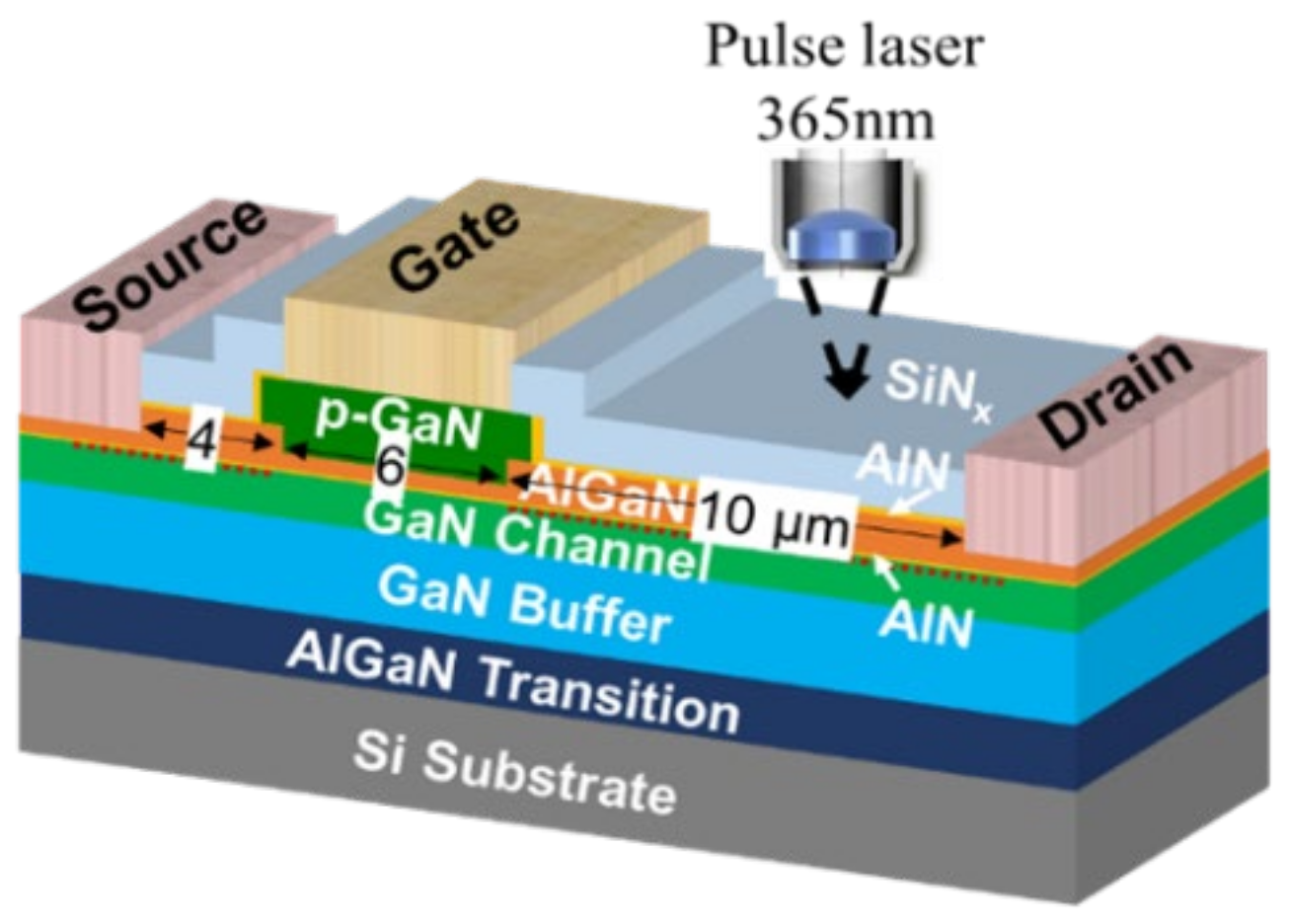

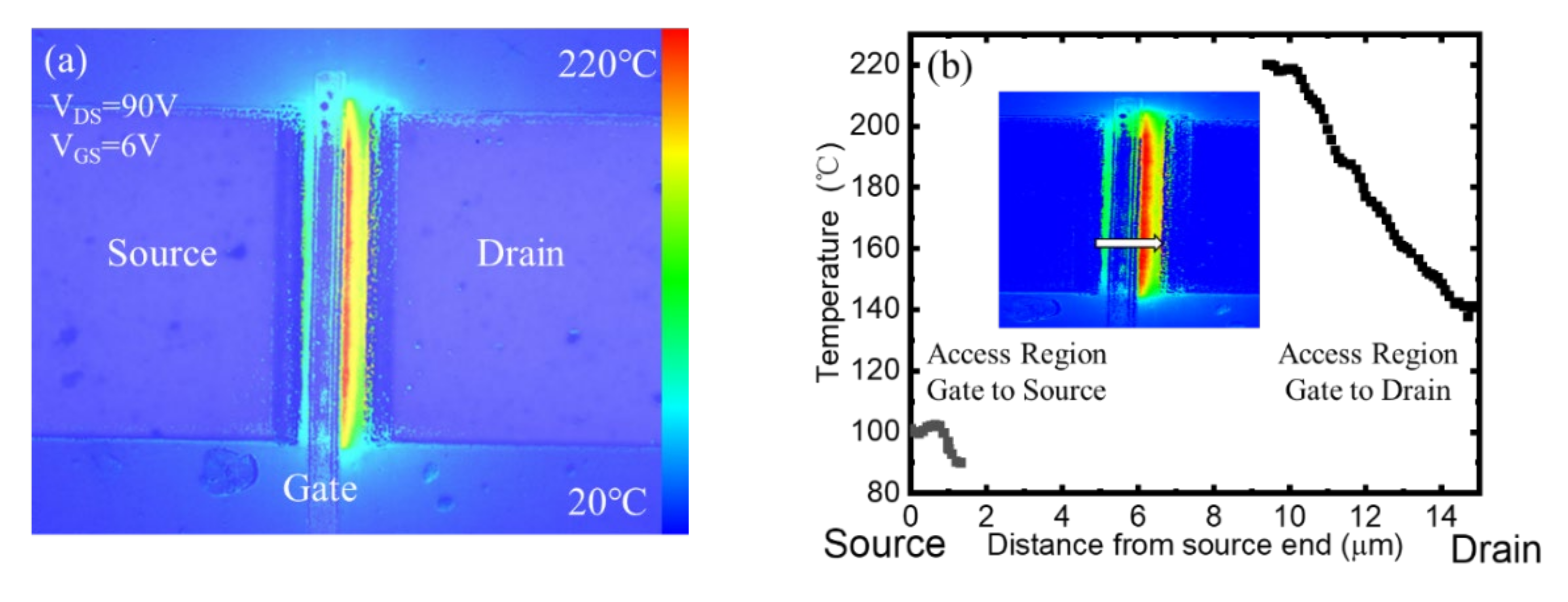

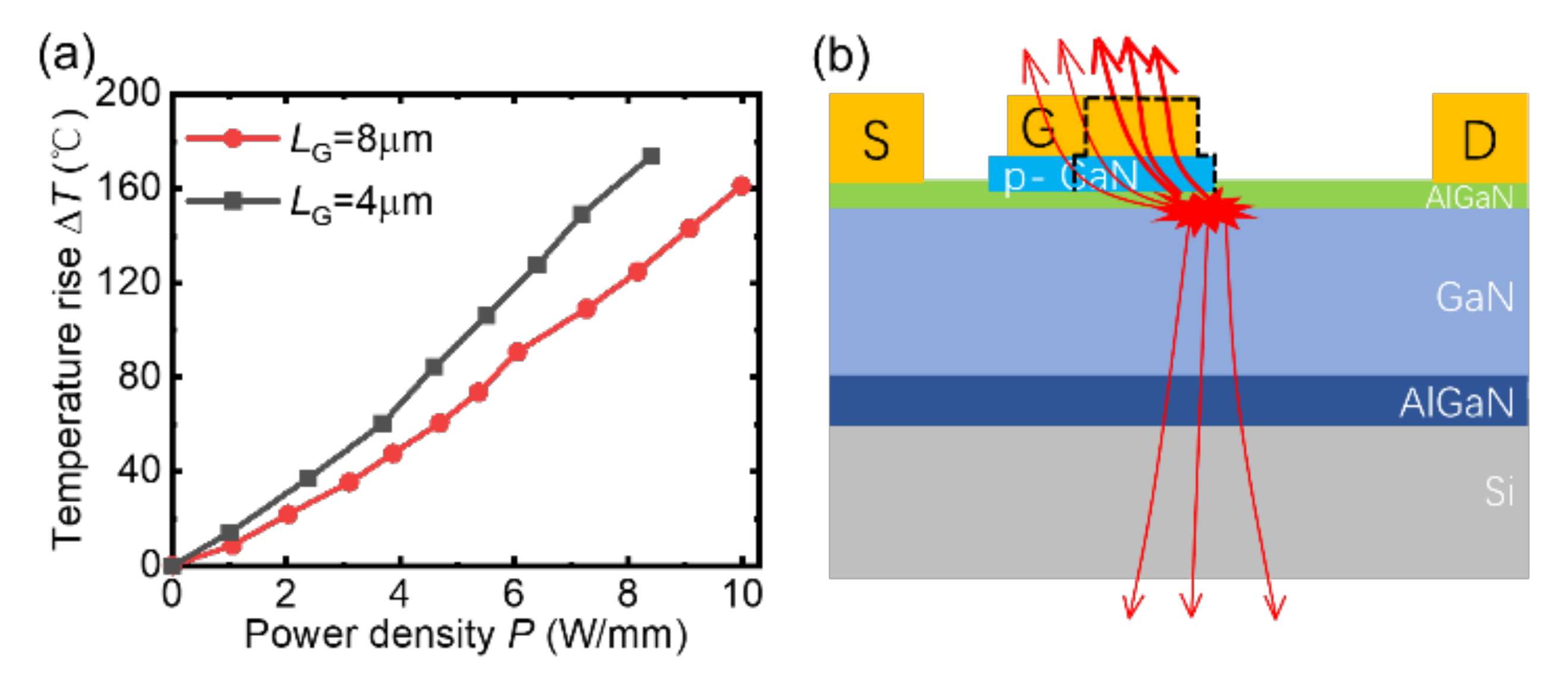

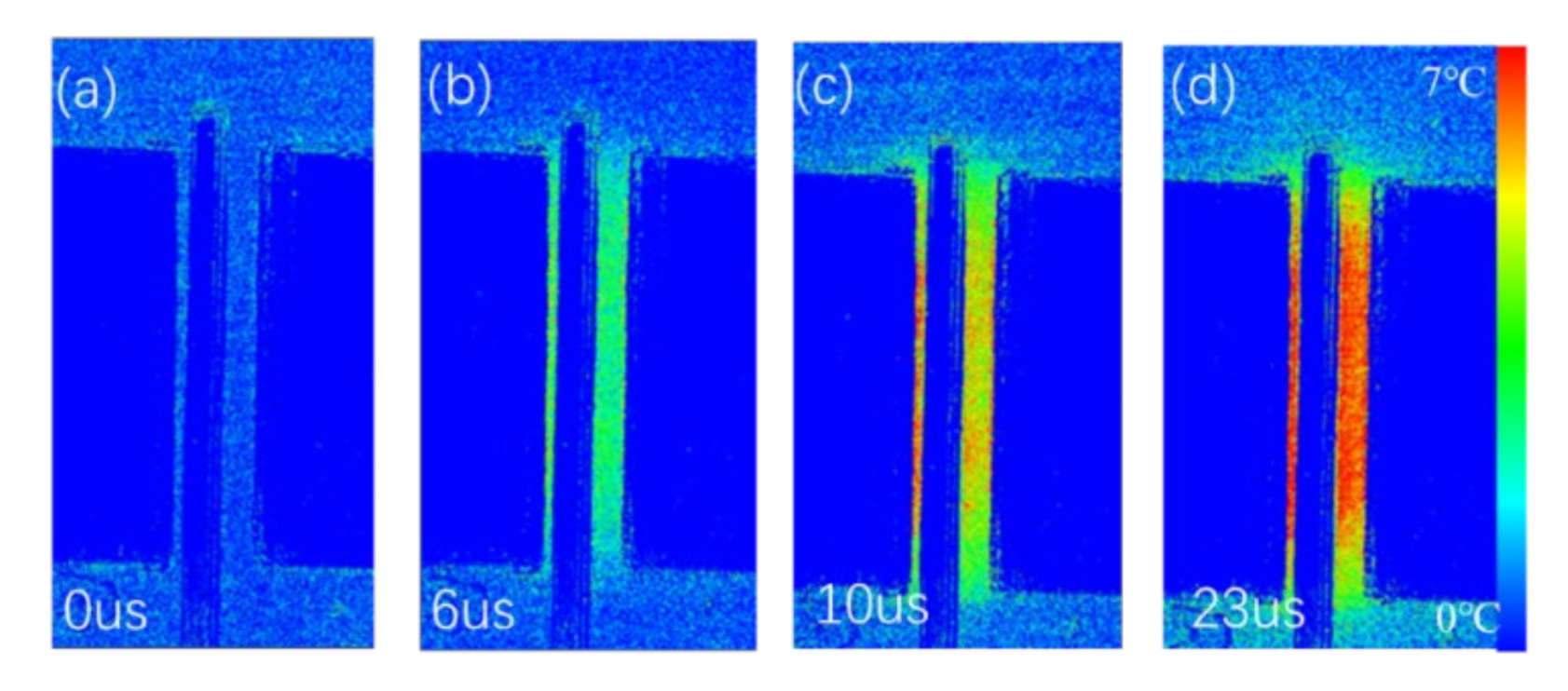
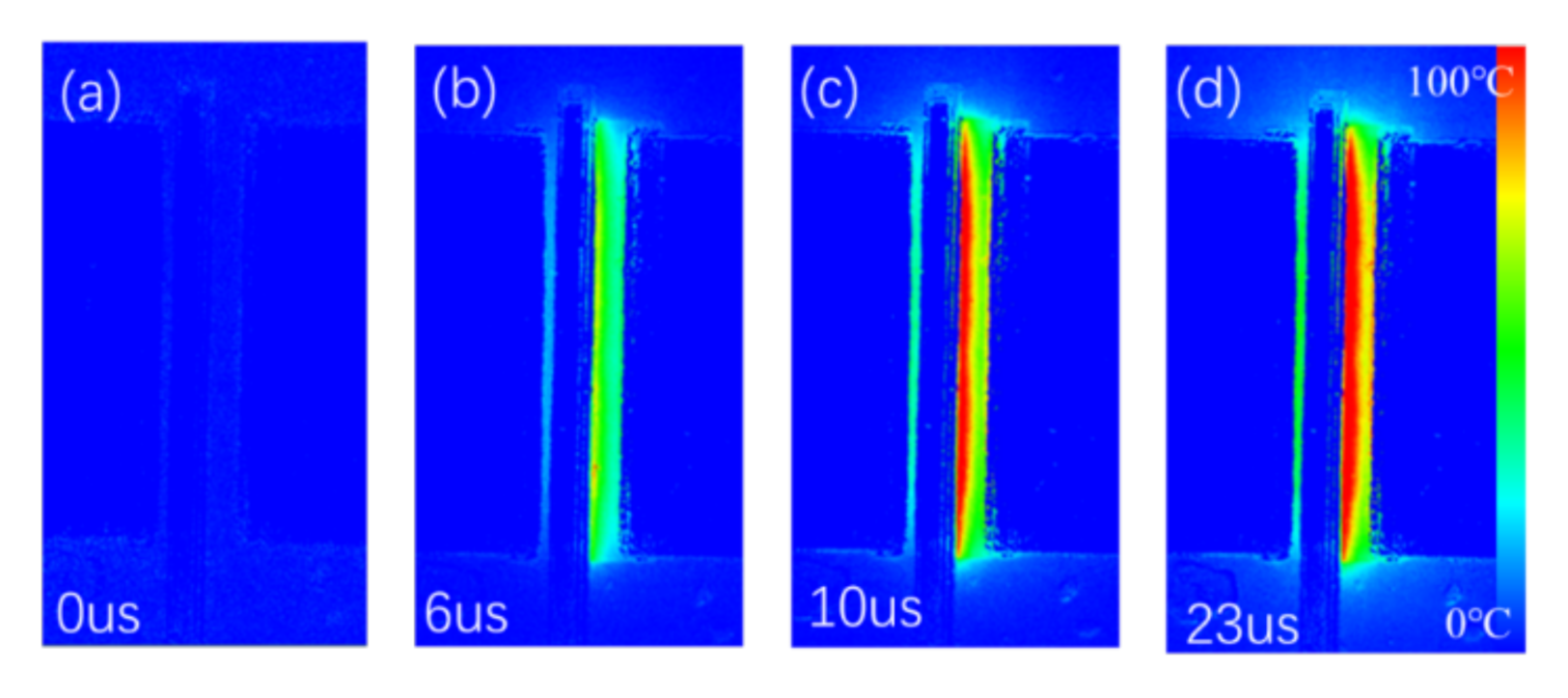
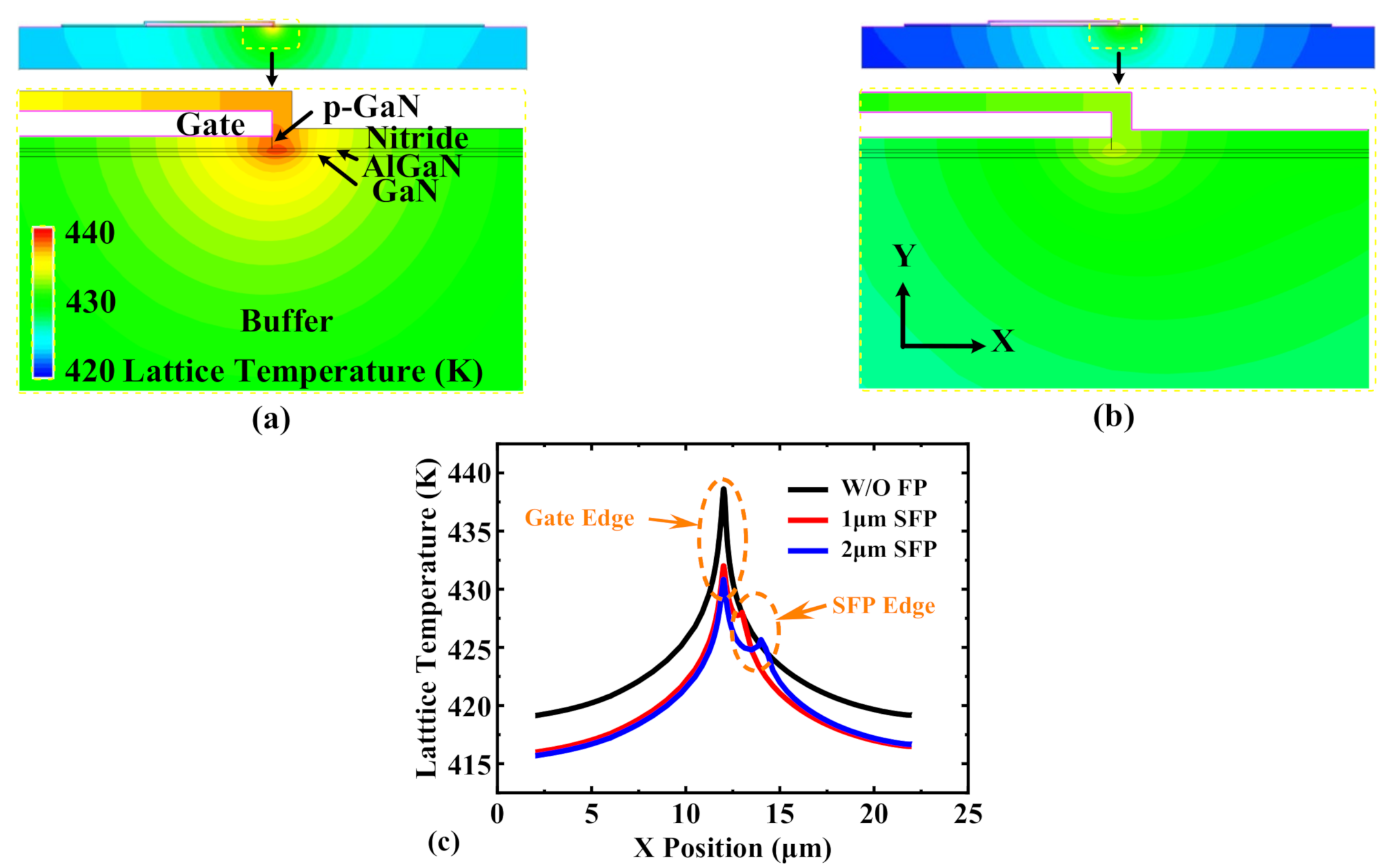
Publisher’s Note: MDPI stays neutral with regard to jurisdictional claims in published maps and institutional affiliations. |
© 2022 by the authors. Licensee MDPI, Basel, Switzerland. This article is an open access article distributed under the terms and conditions of the Creative Commons Attribution (CC BY) license (https://creativecommons.org/licenses/by/4.0/).
Share and Cite
Wang, H.; Yuan, C.; Xin, Y.; Shi, Y.; Zhong, Y.; Huang, Y.; Lu, G. Investigation on the Thermal Characteristics of Enhancement-Mode p-GaN HEMT Device on Si Substrate Using Thermoreflectance Microscopy. Micromachines 2022, 13, 466. https://doi.org/10.3390/mi13030466
Wang H, Yuan C, Xin Y, Shi Y, Zhong Y, Huang Y, Lu G. Investigation on the Thermal Characteristics of Enhancement-Mode p-GaN HEMT Device on Si Substrate Using Thermoreflectance Microscopy. Micromachines. 2022; 13(3):466. https://doi.org/10.3390/mi13030466
Chicago/Turabian StyleWang, Hongyue, Chao Yuan, Yajie Xin, Yijun Shi, Yaozong Zhong, Yun Huang, and Guoguang Lu. 2022. "Investigation on the Thermal Characteristics of Enhancement-Mode p-GaN HEMT Device on Si Substrate Using Thermoreflectance Microscopy" Micromachines 13, no. 3: 466. https://doi.org/10.3390/mi13030466
APA StyleWang, H., Yuan, C., Xin, Y., Shi, Y., Zhong, Y., Huang, Y., & Lu, G. (2022). Investigation on the Thermal Characteristics of Enhancement-Mode p-GaN HEMT Device on Si Substrate Using Thermoreflectance Microscopy. Micromachines, 13(3), 466. https://doi.org/10.3390/mi13030466





